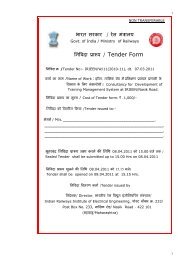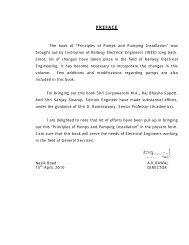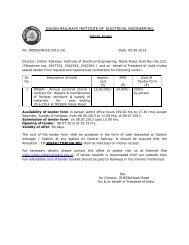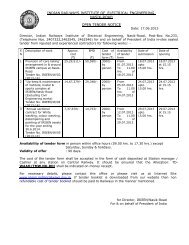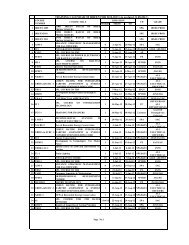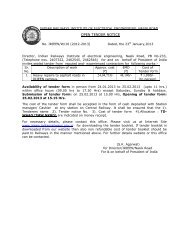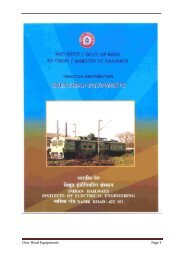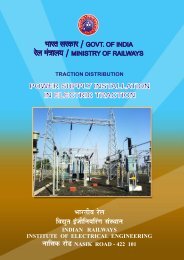Traction Rolling Stock - Indian Railways Institute of Electrical ...
Traction Rolling Stock - Indian Railways Institute of Electrical ...
Traction Rolling Stock - Indian Railways Institute of Electrical ...
Create successful ePaper yourself
Turn your PDF publications into a flip-book with our unique Google optimized e-Paper software.
Drying with cold spray: This is the most efficient method <strong>of</strong> drying oil, and consists<br />
<strong>of</strong> spraying cold oil into a vacuum. The temperature vacuum, however, must be<br />
lower than the temperature <strong>of</strong> evaporation <strong>of</strong> water.<br />
The low pressure and fine dispersion thus obtained considerably aid in the<br />
separation <strong>of</strong> the water which is drawn <strong>of</strong>f by the vacuum pump.<br />
Oil can only be dried by this method if an airtight vessel is available.<br />
1.3 WORKING PRINCIPLE OF TAP CHANGER<br />
1.3.1 Description<br />
The tap changer is directly built on to the transformer. The tappings <strong>of</strong> the transformers<br />
are brought out and arranged in circular fashion on an insulated contact plate. There are two rows<br />
<strong>of</strong> contact segments which are aligned on outer and inner circles <strong>of</strong> the contact plate. An arm<br />
which is known as selector arm is driven by a shaft at the centre <strong>of</strong> the contact plate. Two rollers<br />
are situated at the edge <strong>of</strong> the selector arm. These rollers make connection between the<br />
respective segment in outer or inner rings. These rings are provided in front <strong>of</strong> the contact plate.<br />
The centre shaft which extends outside the tap changer casing is driven by an air servo motor<br />
known as SMGR. The design <strong>of</strong> the air servo motor is such that once the selector arm begins its<br />
movement, it can be stopped only at the required tap (not in between two taps). The connection<br />
between the inner or outer ring to the transformer is being established by means <strong>of</strong> CGR<br />
contactor.<br />
1.3.2 Method <strong>of</strong> operation (Ref. fig. 1.3.2)<br />
The selector arm is actuated by the driving shaft through an intermittent gearing<br />
comprising <strong>of</strong> drive wheel, lantern gear pinion and stopping wheel. This driving shaft also operates<br />
the CGR Cam shaft in sequence with the operation <strong>of</strong> contact rollers. The opening and closing<br />
sequence <strong>of</strong> CGR contactors are given below :<br />
CGR I CGR II CGR III<br />
Even Notches Open Closed Closed<br />
In bet. Notches Closed Closed Open<br />
Odd Notches Closed Open Open<br />
Before the moving contact roller leaves the zero tap contact segment, it touches the first tap<br />
segment. During this the CGRI contactor closes inserting the diverter resistance RGR in between<br />
the tapped winding. This results in shorting <strong>of</strong> the section <strong>of</strong> winding between Tap 'O' and Tap 1<br />
thro. RGR. This resistance RGR restrict the short circuit current when the selector arm further<br />
moves fully on Tap 1, the inner contact roller breaks the contact with zero tap. Meanwhile CGR II<br />
contactor opens and cuts <strong>of</strong>f RGR from circuit. Likewise when the selector arm moves from first<br />
tap to second tap the contact roller (outer) will continue to make connection with Tap 1 segment &<br />
the inner contact roller establishes connection between inner segment and inner ring. (This is due<br />
to over lapping contact segment). At the same time CGRI, CGR II are closed again inserting the<br />
resistor RGR in between the short circuited winding. Now the service current flows from the<br />
contact ring outer in the selector through the resistor RGR, when the selector arm further moves,<br />
the outer roller leaves the Tap l segment & breaks the contact. At the same time CGR I gets<br />
opened and CGR II & CGR III are closed. This again cuts <strong>of</strong>f the resistance RGR.<br />
The opening & closing <strong>of</strong> the CGR contacts is carried out by a cam shaft which is driven




